A two-day strategic design workshop was held with stakeholders working across prison healthcare to review progress, reflect on achievements, and collaboratively shape the next phase of the strategy.
Using a design-thinking lens, the workshop encouraged participants to pause and consider what has been working well, where opportunities for change exist, and how the future of prison healthcare might evolve in response to emerging trends. The aim was to surface collective insights, generate new ideas, and co-develop tangible actions for the next five years.
Process
The workshop was divided into two key components:
- Day 1: Review, Reflect and Recommend
Focused on celebrating successes, assessing current strategic objectives, and identifying opportunities for improvement.
- Day 2: Looking Forward
Focused on future trends, imaginative exploration, and developing actionable priorities for the years ahead.
Throughout both days, participants were guided by a set of collaboration principles designed to foster open, creative and inclusive discussion:
- Defer judgment
- Encourage wild ideas
- Build on the ideas of others
- Be inclusive
- Stay focused on the topic
- Be willing to feel uncomfortable and unsure
Day 1: Review, reflect and recommend
Kick off – setting the scene for good collaboration.
1. Defer judgment
- Encouragewild ideas
- Build on the ideas of others
- Be inclusive
- Stay focused on the topic
- Be willing to feel uncomfortable and unsureEnhanced with a co-design song created with Suno.ai: https://www.youtube.com/shorts/jqvNh4wdnZo
Activity 1: Celebrating Our Successes
The workshop began on a positive note by recognising the work already achieved through the existing strategy. Participants were asked to recall, draw, and share a memorable moment of impact — a time when they felt proud or excited about the difference their work made.
This reflective exercise served several purposes: it created a sense of shared accomplishment, reinforced what good practice looks like, and set an appreciative tone for the day ahead.
Steps:
- Recall a moment of exceptional practice — think of a time when the strategy led to a meaningful or successful outcome.
- Draw the experience — participants captured their story visually, adding a title, brief descriptors, and an optional name.
- Table share — each participant shared their drawing and story with others, helping to surface common themes of success.
This creative exercise encouraged storytelling, connection, and pride — reminding everyone of the real human impact of their work.
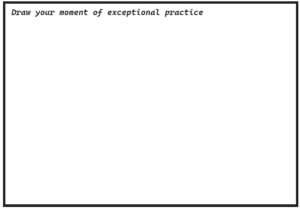 |
 |
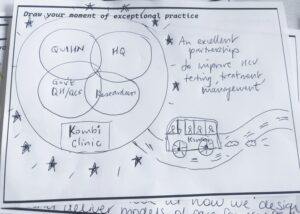 |
 |
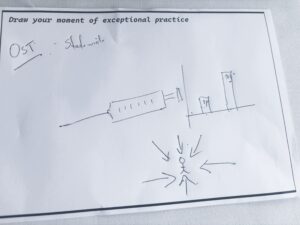 |
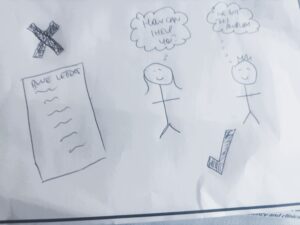 |
A short “beach ball” mini-activity followed, prompting participants to consider how multiple perspectives can be valid at once. By playfully tossing around quick, instinctive “lizard-brain” ideas, participants were reminded that reframing assumptions often begins with curiosity and perspective-taking.
Activity 2: Informing Our Strategic Priorities
Building on the energy of the first activity, participants shifted to a more analytical mode — reflecting on current “bright spots” and “change opportunities” within the existing strategy.
Each table focused on one of seven thematic areas:
- Workforce
- Transition
- Harm reduction
- Culture
- Preventative health
- Digital
- Wildcard (an open category for emerging or cross-cutting issues)
Process:
Groups discussed what was currently working well within their theme and identified areas that could be strengthened or evolved. Each group selected:
- One bright spot: a success worth sustaining or amplifying.
- One change opportunity: a challenge or unmet need that could shape future priorities.
They were encouraged to draw inspiration from other sectors and to use open-ended prompts such as “I like…”, “I wish…”, “I wonder…”, “What if…” to expand their thinking.
Each group then shared back to the larger room in a concise 1–2 minute presentation, ensuring cross-pollination of ideas across all strategic domains.
Activity 3: Assessing the Strategic Objectives
In this final Day 1 activity, the group collectively revisited the four high-level strategic objectives guiding the current work. The goal was to test whether these objectives still captured the full scope of the group’s vision, and if not, how they might be refined.
Discussion prompts included:
- Should we keep, tweak, add, or remove any objectives?
- Are all key ideas or intentions represented?
- Is there an important concept missing that could be integrated into existing objectives rather than creating a new one?
Participants worked together to refine the wording of each objective, ensuring that they were accurate, clear, convincing, and accessible. The session concluded with a group conversation about language, checking whether each statement felt strong, purposeful, and aligned with the values of prison healthcare.
 |
Day 2: Looking Forward
The day kicked off with a reminder of the principles for good collaboration via another song created with Suno.ai: https://www.youtube.com/shorts/bAG52trWBqo
1. Defer judgment
- Encourage wild ideas
- Build on the ideas of others
- Be inclusive
- Stay focused on the topic
- Be willing to feel uncomfortable and unsure
Activity 4: Future Mapping with PESTLE
The second day looked outward, inviting participants to think strategically about the external forces shaping the future of prison healthcare. Using the PESTLE framework (Political, Economic, Social, Technological, Legal, Environmental), groups rotated through discussion tables to explore each dimension.
Each table was tasked with identifying key trends and drivers of change, asking:
- What trends are coming our way?
- How might these forces reshape healthcare in prisons?
- Do our current objectives adequately prepare us for these changes?
After ten minutes at each table, participants shared their highlights, creating a shared map of emerging opportunities and challenges. This exercise encouraged systems thinking and helped align the refreshed strategy with future realities.
Activity 5: Postcards of Possibility
After exploring trends, participants were invited to imagine a bold future. They were asked to picture the year 2030, when prison healthcare has been transformed for the better, and to write a “postcard from the future.”
Each postcard described what had been achieved, the improvements, innovations, and human impacts that had come to life. Participants illustrated their postcards, blending imagination with tangible aspiration.
Once completed, participants gathered at tables that aligned with the themes of their postcards. Each table selected a leader to help combine, cluster, and refine ideas, turning individual visions into collective aspirations. This creative exercise helped participants articulate what success could look like and provided inspiration for defining actionable next steps.
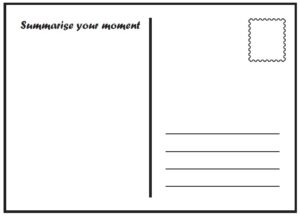 |
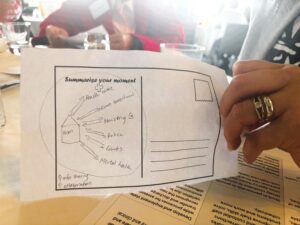 |
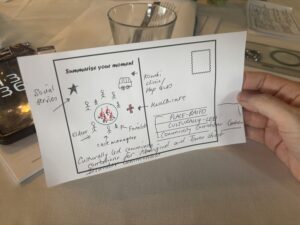 |
Activity 6: Developing Actions
In this final phase, groups worked to translate their imaginative ideas into concrete actions for the next five years (2025–2030). Drawing on insights from their postcards and earlier discussions, participants refined and revised a series of proposed actions that aligned with the updated strategic objectives.
Each table identified their top three priority projects, using a conversational ranking process supported by the 5Rs scale to evaluate each idea:
- Radical – Is it disruptive or transformational?
- Relevant – Does it align with current needs or momentum?
- Realistic – Can it endure and adapt over time?
- Resonant – Does it connect with values and lived experience?
- Resourceful – Does it make effective use of available capability and assets? (added for completeness)
Groups then prepared to present their top priorities and rationale to the larger room. This activity consolidated the two days of reflection, imagination, and collaboration into a set of clear, actionable priorities that the team could take forward.
Chief Investigators
Partners
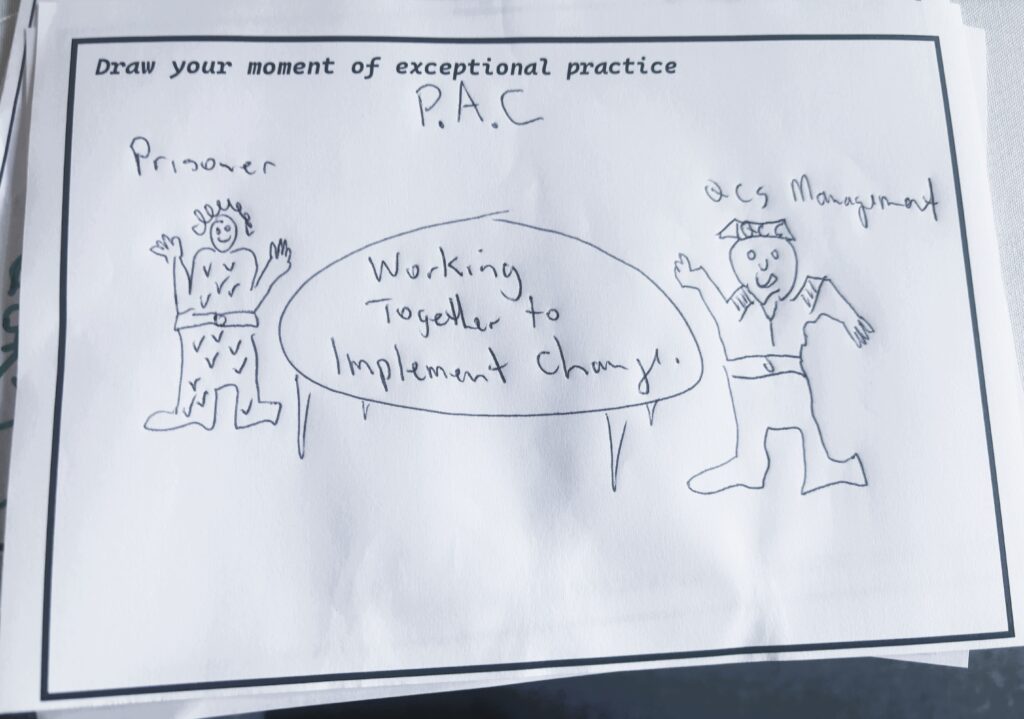
 Queensland Health
Queensland Health